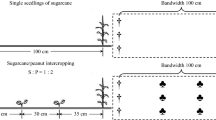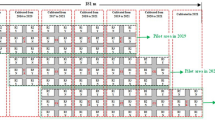Abstract
Sugarcane and sugarbeet farmers experience lower strip cane and beet root yields, respectively, and need to have a comprehensive package of production technology. The current field study evaluated the production and economic prospects of sugarcane–sugarbeet intercropping through enhanced fertilizer dosage for 2 years. Sugarcane variety “HSF-240” and sugarbeet variety “Antak” were grown. Experiment was performed in randomized complete block design with two-factorial arrangement, and it was quadruplicated. Factor-1 treatments in main plots comprised of sole cultivation of sugarcane and sugarbeet as well as intercropping of both. Sugarbeet was intercropped with sugarcane on 90-cm-spaced rows. Factor-2 in subplots included various fertilizer (F) rates equally that of nitrogen (N), phosphorus (P) and potassium (K) as N–P2O5–K2O, viz. F0, F100, F150, F200, F250 and F300, representing 0, 100, 150, 200, 250 and 300 kg ha−1, respectively. Data regarding crop yield attributes (millable canes and beets per m2, weight of stripped cane and beet root), yield of crops and sugar production rendered non-significant difference between intercropping and sole cultivation system of sugarcane and sugarbeet; although there were slightly higher values for sole planting. Number of millable canes and beets per m2, weight per stripped cane and beet root, stripped cane and beet yield, and sugar recovery and yield significantly enhanced with each increment of NPK level. The most appropriate dose of NPK was 250 kg ha−1 with respect to crop and sugar production as well as for maximum economic returns from sugarcane as higher NPK dose 300 kg ha−1 did not had further significant positive effect. However, single root weight, crop and sugar yield of sugarbeet were significantly higher with 300 kg NPK ha−1 as compared to that from 250 kg NPK ha−1 both under sole and intercropping plantation system. Sugarcane–sugarbeet intercropping turns superior to traditional sole cultivation system under enhanced plant nutrient dosage up to 250 kg NPK ha−1, whereas further increase in fertilizer dose reduces the economic returns. Beyond this level of NPK fertilizer, the purity of sugar and its recovery could become deteriorated.


Similar content being viewed by others
References
Aziz, M., A. Mahmood, M. Asif, and A. Ali. 2015. Wheat-based intercropping: A review. Journal of Animal and Plant Sciences 25(4): 896–907.
Bahadar, K., M. Sadiq, M. Subhan, A.U. Khan, P. Khan, and D. Khan. 2007. Production potential of sugar beet intercropping with sugar cane under various planting geometry system. Pakistan Sugar Journal 22(l): 76–81.
Bhoi, P.G., and B.J. Takalkar. 2008. Present scenario of sugar industry in Maharashtra and it’s future strategies. Cooperative Sugar 40(3): 41–48.
BSES. 1984. Laboratory Manual for Australian Sugar Mills, vol. 2. Indooroopilly: Bureau of Sugar Experiment Stations.
Dhaka, A.K., R.K. Pannu, S. Kumar, K. Malik, and B. Singh. 2015. Biological feasibility, economic viability and energy efficiency of intercropping fodder sorghum (Sorghum bicolor) in seed crop of dhaincha (Sesbania aculeata). Indian Journal of Agricultural Sciences 85(1): 20–27.
Hussain, S., M. Anwar-ul-Haq, S. Hussain, Z. Akram, M. Afzal, and I. Shabbir. 2017. Best suited timing schedule of inorganic NPK fertilizers and its effect on qualitative and quantitative attributes of spring sown sugarcane (Saccharum officinarum L.). Journal of the Saudi Society of Agricultural Sciences 16:66–71.
Jagtap, S.M., M.B. Jadhav, and R.V. Kulkarm. 2006. Effect of levels of NPK on yield and quality of suru sugarcane (cv. Co. 7527). Indian Sugar 56:35–40.
Islam, M.S., M.K. Bejun, M.R. Alam, and M.S. Arefin. 2013. Evaluation of some qualitative and quantitative characters of ten sugarcane genotypes under water logging stress conditions. Pakistan Sugar Journal 28(1): 10–15.
Khan, I.A., A. Khatri, G.S. Nizamani, M.A. Siddiqui, S. Raza, and N.A. Dahar. 2005. Effect of NPK fertilizers on the growth of sugarcane clone AEC86-347 developed at NIA, Tando Jam, Pakistan. Pakistan Journal of Botany 37(2): 355–360.
Kumar, N., H. Singh, R. Kumar, and G. Kumari. 2014. Nutrient uptake, sugarcane yield and economics of high sugar early genotypes of sugarcane (Saccharum sp hybrid complex) under various planting seasons and fertility levels in Bihar. Indian Journal of Agricultural Sciences 84(4): 444–451.
Latif, A., G. Jilani, R. Hayat, A.A. Khan, M. Azeem, M. Ehsan, and M.U. Mubarak. 2017. Isolation, Characterization of PSB stains from rock phosphate and their potential as biofertilizer. International Journal of Biosciences 10(1): 72–80.
Layek, J., B.G. Shivakumar, D.S. Rana, S. Munda, K. Lakshman, A.S. Panwar, A. Das, and G.I. Ramkrushna. 2015. Performance of soybean (Glycine max) intercropped with different cereals under varying levels of nitrogen. Indian Journal of Agricultural Sciences 85(12): 1571–1577.
Mekdad, A.A.A. 2015. Sugar beet productivity as affected by nitrogen fertilizer and foliar spraying with boron. International Journal of Current Microbiology and Applied Sciences 4:181–196.
Mekdad, A.A.A., and M.M. Rady. 2016. Response of Beta vulgaris L. to nitrogen and micronutrients in dry environment. Plant, Soil and Environment 62(1): 23–29.
Miller, G.I. 1959. Use of dinitrosalicylic acid reagent for determination of reducing sugars. Analytical Chemistry 31:426–428.
Oad, F.C., M.U. Usmanikhail, M.H. Siddiqui, and N. Junejo. 2008. Response of sugar beet (Beta vulgaris) (variety Kaweterma) to different fertility levels. Pakistan Sugar Journal 23(2): 5–10.
Rahman, M.S., S. Khatun, and M.K. Rahman. 2016. Sugarcane and sugar industry in Bangladesh: An overview. Sugar Tech 18(6): 627–635.
Rehman, A., A. Ali, Z. Iqbal, R. Qamar, S. Afghan, and A. Majid. 2014a. Maximum economic return through intercropping of different crops in September sown sugarcane (Saccharum officinarum L.). Pakistan Sugar Journal 24(2): 7–14.
Rehman, A., R. Qamar, and J. Qamar. 2014b. Economic assessment of sugarcane (Saccharum officinarum L.) through intercropping. Journal Agricultural Chemistry and Environment 3:24–28.
Salami, M., and S. Saadat. 2013. Study of potassium and nitrogen fertilizer levels on the yield of sugar beet in jolge cultivar. The Journal of Novel Applied Sciences 2:94–100.
Shrivastava, A.K., S. Solomon, R.K. Rai, P. Singh, A. Chandra, R. Jain, and S.P. Shukla. 2015. Physiological interventions for enhancing sugarcane and sugar productivity. Sugar Tech 17(3): 215–226.
Shukla, S.K., K.K. Singh, A.D. Pathak, V.P. Jaiswal, and S. Solomon. 2017. Crop diversification options involving pulses and sugarcane for improving crop productivity, nutritional security and sustainability in India. Sugar Tech 19(1): 1–10.
Solanki, M.K., Z. Wang, F.-Y. Wang, C.-N. Li, T.-J. Lan, R.K. Singh, P. Singh, L.-T. Yang, and Y.-R. Li. 2017. Intercropping in sugarcane cultivation influenced the soil properties and enhanced the diversity of vital diazotrophic bacteria. Sugar Tech 19(2): 136–147.
Soomro, A.F., S. Tunio, M.I. Keerio, I. Rajper, Q. Chachar, and M.Y. Arain. 2014. Effect of inorganic NPK fertilizers under different proportions on growth, yield and juice quality of sugarcane (Saccharum officinarum L). Pure and Applied Biology 3(1): 10–18.
Steel, R.G.D., J.H. Torrie, and D. Dicky. 1997. Principles and Procedures of Statistics: A Biometrical Approach, 3rd ed, 204–227. Singapore: McGraw Hill Book Co., Inc.
Tsialtas, J.T., and N. Maslaris. 2005. Effect of N fertilization rate on sugar yield and non-sugar impurities of sugar beets (Beta vulgaris) grown under mediterranean conditions. Journal of Agronomy and Crop Science 191:330–339.
Ullah, G., E.A. Khan, I.U. Awan, M.A. Khan, A.A. Khakwani, M.S. Baloch, Q.U. Khan, M.S. Jilani, K. Wasim, G. Jilani, and M. Ullah. 2013. Wheat response to fertilizer application techniques and nitrogen levels: II. Crop growth and yield attributes. Pakistan Journal of Nutrition 12(7): 636–641.
Wains, G.M., M.A. Mudassir, A. Ghaffar, N. Fiaz, M.A. Sarwar, Z. Ali, and M.F.H. Ferdosi. 2012. Performance of autumn planted sugarcane at varied fertilizer levels. Mycopath 10(1): 21–23.
Author information
Authors and Affiliations
Corresponding authors
Ethics declarations
Conflict of interest
The authors declare that they have no conflict of interest. Further, this study was not financially supported by any funding agency.
Rights and permissions
About this article
Cite this article
Ullah, S., Khan, E.A., Jilani, G. et al. Sugarcane–Sugarbeet Intercropping Augments Cumulative Crop/Sugar Production and Financial Turnovers Under Enhanced Fertilization. Sugar Tech 20, 431–438 (2018). https://doi.org/10.1007/s12355-017-0551-5
Received:
Accepted:
Published:
Issue Date:
DOI: https://doi.org/10.1007/s12355-017-0551-5




